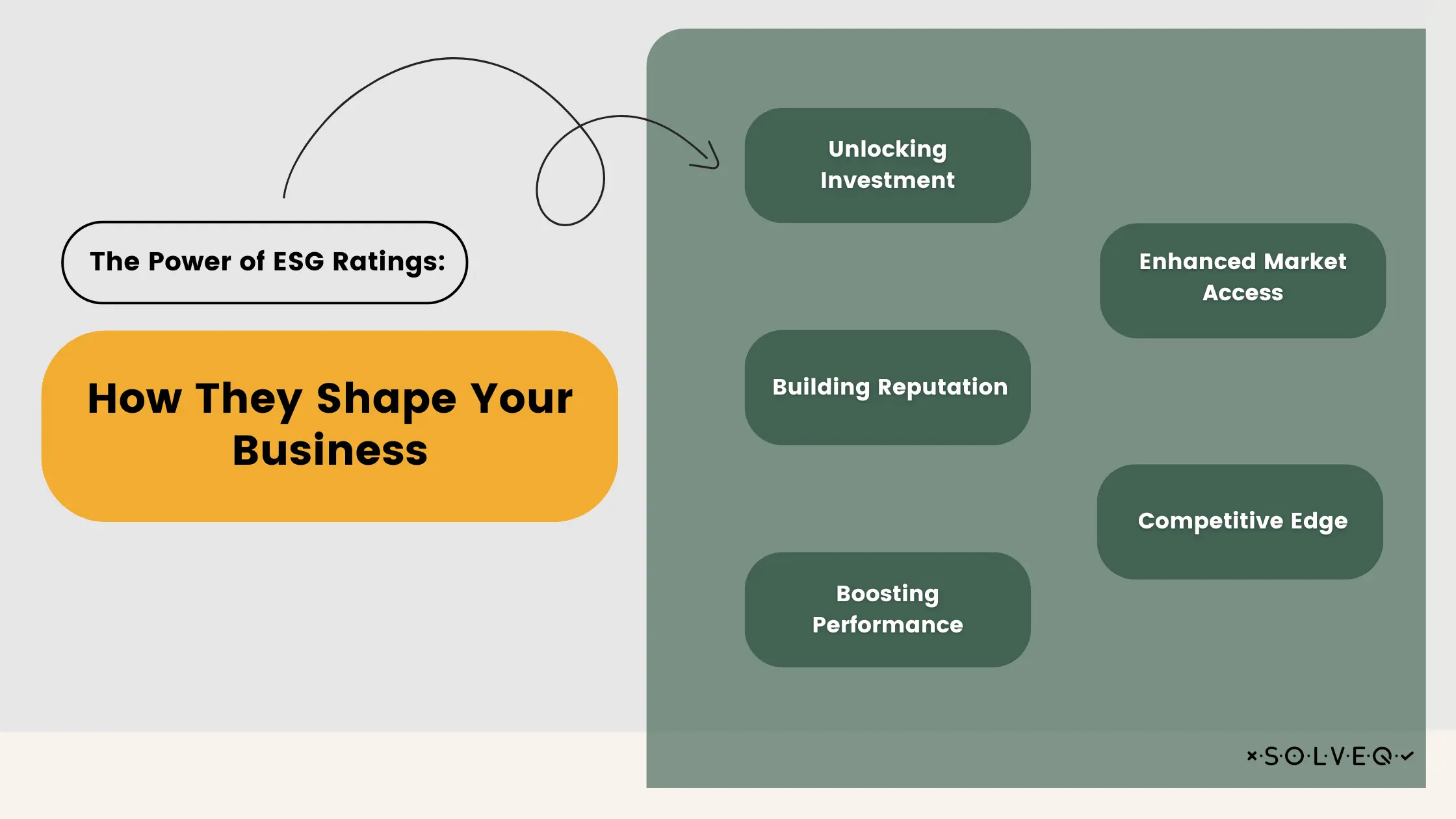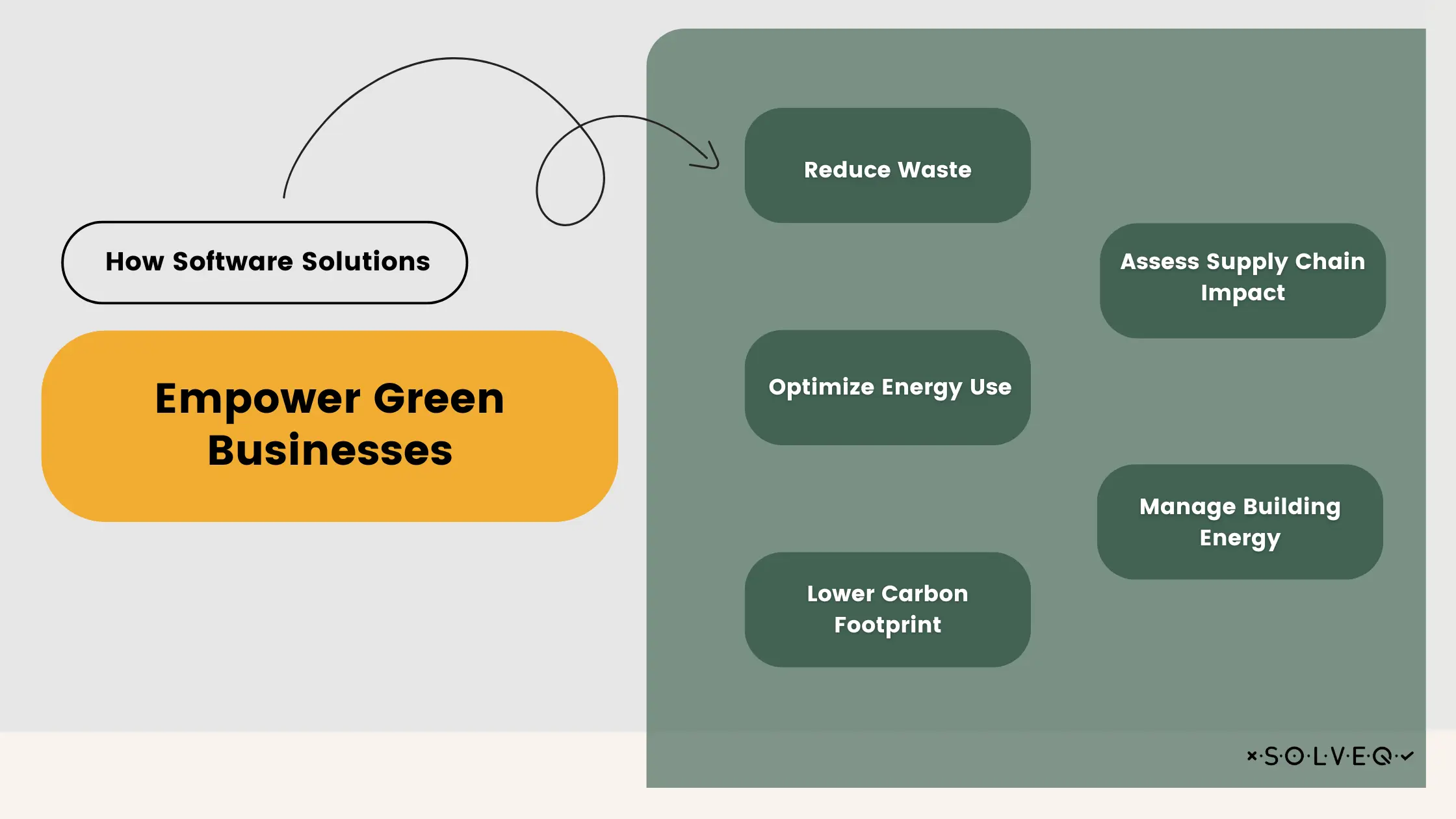Sustainability Software Development: Harnessing Technology for a Greener Future
18 Apr 2024 • 16 min read

Marcin Kulawik

Our planet faces critical environmental threats. Thankfully, companies are prioritizing sustainability like never before. Custom software solutions offer a powerful tool to optimize resource management and shrink carbon footprints. Across various areas, from energy use to supply chains, these solutions empower businesses to achieve their ESG goals and create a positive impact
In this post, I'll draw on my experience as both a vegan advocate and founder of a custom software development company focused on sustainability. Together, we'll explore some of the most common environmental challenges businesses face, and how software solutions can help them achieve a greener transformation.
What is ESG? A Framework for Sustainable Businesses
ESG stands for Environmental, Social, and Governance. It's a framework that helps businesses operate responsibly and sustainably. Companies that embrace ESG integrate these factors into their core practices, from minimizing their environmental impact to promoting a positive social impact.
Here's how ESG can benefit businesses:
Environmental:
- Transitioning to renewable energy sources reduces reliance on fossil fuels and lowers carbon footprint.
- Implementing eco-friendly practices minimizes waste and promotes resource conservation.
Social:
- Fostering diversity and inclusion creates a more equitable and representative workplace.
- Investing in employee training and development empowers and motivates the workforce.
- Contributing to local communities strengthens relationships and builds goodwill.
Governance:
- Establishing responsible supply chain management ensures ethical sourcing practices.
- Strong governance practices promote transparency, accountability, and long-term value creation.
Beyond the benefits, sustainable practices are likely to become mandatory in the near future. This means every company will need to prioritize ESG.
The Power of ESG Ratings: How They Shape Your Business
ESG ratings, which assess a company's environmental, social, and governance practices, are no longer a niche concern. These ratings are becoming a critical factor for investors, customers, and other stakeholders. Here's how a strong ESG rating can benefit your business:

- Unlocking Investment: Investors increasingly prioritize sustainable companies, making high ESG ratings a magnet for capital.
- Building Reputation: Demonstrating strong ESG practices translates to a positive brand image, fostering trust and loyalty.
- Boosting Performance: Studies suggest companies with robust ESG practices often outperform competitors financially.
- Enhanced Market Access: High ESG ratings can open doors to attractive financing options and smoother capital acquisition.
- Competitive Edge: Attract top talent and environmentally conscious customers by showcasing your commitment to sustainability.
In essence, ESG ratings are a powerful tool for businesses to thrive in today's market. By prioritizing ESG principles, you position your company for success in a future where sustainability is no longer optional.
Why do businesses invest in environmental software?
Environmental software is rapidly gaining popularity among companies looking to reduce their carbon footprint and minimize waste. Several factors drive this trend, including increased public awareness and concern for the environment, government regulations and incentives to encourage sustainable practices, and the potential for cost savings through improved efficiency.
In addition, companies are seeking to differentiate themselves in the marketplace by highlighting their commitment to sustainability and environmental responsibility, which can serve as a competitive advantage. Technological advancements in data analysis and monitoring have also made it easier for companies to assess their environmental impact and take action to reduce it.
These factors demonstrate the importance of environmental software in today's business landscape. Companies that adopt these solutions can meet sustainability demands while driving operational efficiency and business success. This makes environmental software a valuable tool for companies looking to impact the environment and their bottom line positively.
How Software Solutions Empower Green Businesses
Environmental software plays a crucial role in a company's sustainability journey. These solutions offer a variety of tools to:

- Reduce Waste: Track and minimize waste generation throughout the supply chain, including recycling, composting, and food waste reduction strategies.
- Optimize Energy Use: Monitor and manage energy consumption, pinpoint areas for improvement, and implement energy-saving strategies like smart lighting systems or automated temperature controls.
- Lower Carbon Footprint: Implement comprehensive carbon footprint tracking systems to identify emission sources and prioritize reduction strategies.
- Assess Supply Chain Impact: Evaluate the environmental impact of a company's entire supply chain, from sourcing raw materials to product delivery.
- Manage Building Energy: Monitor and control energy usage in buildings (lighting, HVAC, water) to minimize waste and lower energy costs.
Enterprise Carbon and Energy Management (ECEM) Software: A Deep Dive
ECEM software is a powerful tool for organizations to comprehensively manage their carbon emissions and energy consumption. Its primary goal is to:
- Reduce Carbon Footprint and Energy Costs: Minimize environmental impact and optimize energy efficiency, leading to cost savings.
Common Features of ECEM Software:
- Real-time Data Tracking: Monitor energy consumption and carbon emissions in real-time for continuous improvement.
- Detailed Reporting: Gain insights into usage patterns and trends through comprehensive energy and carbon reports. These reports are valuable for both internal analysis and regulatory compliance.
- Emissions Reduction Planning: Develop and implement a data-driven strategy to reduce emissions and enhance energy efficiency.
- Energy Management Integration: Integrate ECEM software with building management systems for real-time monitoring and control of energy use.
- Sustainability Reporting: Generate sustainability reports and track relevant KPIs to demonstrate progress towards environmental goals.
By implementing ECEM software, companies can achieve significant sustainability improvements while reducing energy costs.
Examples of ECEM Software:
The list of ECEM software providers is constantly evolving. Here are a few prominent examples:
- Carbon Trust: Helps organizations monitor and reduce their carbon footprint, manage energy and resources, and oversee sustainability initiatives.
- Enablon: A comprehensive sustainability management software that tracks environmental, social, and governance (ESG) performance, including energy and carbon management.
- Verisae: Cloud-based ECEM software helping organizations monitor, manage, and decrease energy consumption, carbon emissions, and associated costs.
- EnerNOC: An energy management platform providing real-time data and analysis to optimize energy use, cut costs, and improve sustainability.
- BuildingIQ: Utilizes machine learning to optimize HVAC systems, reduce energy consumption, and enhance building performance in a cloud-based ECEM platform.
- Ecova: Offers data-driven insights and solutions to help organizations decrease energy use, improve sustainability, and reduce costs.
- EFI Optitex: Specifically designed for the textile and apparel industry, this software helps companies monitor and reduce energy consumption, enhance sustainability, and streamline supply chain operations.
With a wide range of software solutions available, companies can find the perfect tools to accelerate their journey towards a greener future.

The Brains Behind Smarter Infrastructure
Smart Infrastructure Management Software helps organizations optimize the performance of their physical assets, from buildings and transportation systems to utility networks. Imagine a central nervous system for your infrastructure! This software integrates data from sensors, controls, and meters, providing real-time insights that can:
- Boost Efficiency and Reliability: Optimize infrastructure operations to ensure smooth functioning and minimize disruptions.
- Reduce Costs and Energy Use: Identify areas for energy savings and implement strategies to lower operational expenses.
- Enhance Sustainability: Promote environmentally friendly practices and reduce the environmental footprint of infrastructure operations.
- Predict and Proactively Maintain: Leverage predictive analytics to anticipate problems before they arise, allowing for proactive maintenance and upgrades.
Examples of Smart Infrastructure Management Software Solutions
Several cloud-based and web-based Smart Infrastructure Management Software options are available:
- IBM TRIRIGA: A comprehensive cloud platform for managing the entire lifecycle of physical assets, including space, facilities, and sustainability.
- Archibus: A web-based platform that helps organizations manage their real estate, infrastructure, and facilities, offering features like space planning, maintenance management, and lease administration.
- FM:Systems: A cloud-based solution specifically designed to streamline facility operations.
By implementing Smart Infrastructure Management Software, organizations can gain a centralized view of their infrastructure, optimize performance, and ensure long-term sustainability.
Streamlining Sustainability Reporting
Sustainability and ESG (Environmental, Social, and Governance) reporting software streamlines the process of measuring and communicating a company's ESG performance. These solutions offer tools to:
- Gather and Analyze Data: Collect data on key ESG metrics like carbon emissions, energy use, waste management, diversity initiatives, and employee well-being.
- Simplify Reporting: Automate report generation for various sustainability frameworks and regulatory requirements, saving time and resources.
- Track Progress and Set Goals: Monitor performance over time, identify improvement opportunities, and establish clear sustainability goals.
- Enhance Transparency and Communication: Effectively communicate ESG efforts and achievements to stakeholders.
By using this software, companies can demonstrate their commitment to sustainability, boosting their reputation and attracting environmentally and socially conscious investors and customers.

- EcoVadis: A leading provider of sustainability ratings and software, offering comprehensive ESG performance management tools.
- OneTrust ESG: A cloud-based platform for managing all aspects of ESG data collection, reporting, and risk mitigation.
- Sphera: Specializes in sustainability software solutions, including tools for carbon footprint management, ESG data management, and supply chain sustainability.
Optimizing Buildings with Smart Energy Management
Building Energy Management Software (BEMS) empowers facility managers to take control of a building's energy consumption. It acts as a central nervous system, integrating various systems like HVAC, lighting, and security. This allows for:
- Real-time Energy Monitoring: Gain immediate insights into energy usage patterns to identify areas for improvement.
- Data-Driven Optimization: Leverage analytics and automation to optimize energy use for significant cost savings.
- Enhanced Sustainability: Reduce energy consumption and carbon footprint, contributing to a greener future.
- Predictive Maintenance: Anticipate potential equipment issues and schedule maintenance proactively, preventing downtime and ensuring peak performance.
By implementing BEMS, organizations can transform their buildings into smart, energy-efficient environments.
Examples of Modern Building Energy Management Software:
Here are a few prominent BEMS providers offering cutting-edge solutions:
- BuildingIQ: Utilizes machine learning to optimize HVAC systems for energy savings and improved building performance (cloud-based).
- Siemens Desigo CC: A comprehensive building management platform encompassing energy monitoring, HVAC control, lighting control, and access control (integrates with BEMS solutions).
- Planon Universe Platform: A cloud-based IWMS (Integrated Workplace Management System) offering features like BEMS functionality, space management, and maintenance management.
- Honeywell Enterprise Buildings Integrator (EBI): Provides real-time building data visualization, analytics, and control capabilities for energy optimization (integrates with BEMS solutions).

When to Choose Custom Environmental Software: Navigating the Evolving Regulatory Landscape
As environmental regulations tighten and 2024 standards come into effect, many companies are finding off-the-shelf software solutions falling short. Here's where custom environmental software shines:
- Compliance Edge: A custom solution can be built to meet your specific needs and ensure compliance with evolving regulations, giving you a proactive edge.
- Seamless Integration: Integrate seamlessly with existing systems to avoid data silos and streamline environmental management processes for maximum efficiency.
- Future-Proof Scalability: Custom software can be designed to scale alongside your company's growth, adapting to changing data needs and regulations.
- Competitive Advantage: Tailored solutions addressing your unique environmental challenges can differentiate you from competitors struggling with generic software.
While off-the-shelf solutions may have their place, navigating the increasingly complex world of environmental management often calls for a customized approach. A custom software solution empowers you to stay ahead of the curve and achieve your sustainability goals.
Summary
Feeling overwhelmed by environmental regulations and ambitious sustainability goals? This article explored how environmental software empowers companies to navigate this complex landscape.
These innovative tools help businesses:
- Reduce their environmental footprint by tracking and minimizing waste, optimizing energy use, and lowering carbon emissions.
- Stay compliant with evolving regulations, ensuring smooth operations and a competitive edge.
- Boost efficiency and profitability by streamlining processes, reducing energy costs, and unlocking long-term savings.
Ready to transform your sustainability efforts with technology? SolveQ is your partner in creating a greener future. We offer custom software development and seamless integration of existing solutions to fit your needs. Contact SolveQ today and let's unlock the power of sustainability software for your business!
Share:
Looking for expert development team?
Schedule a call with Tech Consultant

Marcin Kulawik
Founder and CEO of SolveQ. Huge fan of building things with purpose, agility, and having fun while changing the World. Loves his family, teammates, and nature.